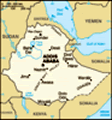Advertisement
Published: December 30th 2007
"I weary of writing more about these buildings because it seems to me that I shall not be believed if I write more ... but all that is written is truth and there is much more that what I have written, and I have left it that they may not tax me with its being falsehood" Francisco Alvares - 16th century Portuguese written upon travelling to Lalibela
Well, our travels to Lalibela were cut a little short by Ethiopian Airlines who told us that the flight was late and they would not have time to travel their full route so would need to by-pass Lalibela. As we are finding out, not only is road travel time consuming in Ethiopia, but plane travel with its short hops, skips and jumps in our little 50 seater Fokker can also be a bit slow. Since there were only 5 of us (our American friends Steve, Susan and Noah + us), we figured that they cancelled it to save fuel! I wouldn't be surprised. We were put up overnight in a better hotel in Axum and treated to good meals at the airlines expense. Finally the day after we landed in the legendary
Lalibela, known as Ethiopian's Petra.
Not as old as Axum, but inheriting its wonderful pedigree of skilled masons, Lalibela came to prominence in the 12th or 13th century and was originally known as Roha. Legend has it that King Lalibela was exiled or fled to Jerusalem in fear of persecution from his half brother. Seeing the buildings at Roha, he vowed to return and create a new Jersalem on African soil. Perhaps that is why many of the names in the town echo those of Jerusalem like the River Jordan.
While there is no consensus over who built the churches, it is well known that Lalibela is situated in an extremely remote location at 2600m and to this day has very poor road access. Only the opening of the airport in 2000 has begun to change its fate in terms of increased exposure to tourism and the outside world. It is changing rapidly, however, and now is the time to see it while it is still quaint.
As soon as we landed and began to drive on the one paved road from the airport into town I knew that I was going to love this place. It
is the first and only place that we've travelled in in Ethiopia that exuded a real travellers' vibe, and contrary to places like Axum where hotels have sprouted up on the side of the dusty highway, in Lalibela the hotels have mixed and mingled within the town so that it's not unusual to get involved in the evening soccer, tetherball or foozeball game going on right outside your hotel door or be crushed within the throng of children coming home from school.
But the star attractions are found in the Northern and Southern Enclosures and just like Francisco Alvares, I can not even begin to do justice to their wonders here. They are dffierent than the rock hewn churches in other areas because they are entirely free from the rock and carved in such a refined manner. The skill is absolutely awe inspiring and Kurt and I found ourselves jaw dropping with "ohs and ahs" at every twist and turn.
Each church is entirely different and has their own personalities and their own priests - some of who are characters. The ritual for each church is to admire the unique architecture, the arches, the frescoes and the vaulted
ceilings, but then to wait for the priest to put on his robes and bring out the cross of the church. Every church has its own as it has for centuries and the priests are its guardians. The detail on the crosses is highly symbolic and mirrors the architectural details of the building which has the same meanings.
Another amazing feature is the tunnels that you have to crawl through the access other areas of the compound which create an aura of mystery with their entry into the unknown. The heavy wooden doors that close off various areas and provide alternate access are made from olive trees and every church has its communion areas and fertility pools for woman who are having difficulty conceiving.
While you can get through the sites in one day which we had to do since that was all that we had, two days would be much more leisurely so you could actually just soak in the atmosphere. Our guide was fantastic, however, at conveying a ton of information to us and fully indoctrinating us into the Lalibela life and was highly recommended. There are no worries with official versus rogue guides here either
because only official guides are permitted to enter the sites and their ID cards are checked rigorously.
Most of the churches are being covered over with scaffolding for conservation reasons which makes photography a little challenging, but Bet Giyorgis, standing all on its own, remains for all the world to see in its glory. We approached it like seeing a famous rock star after having heard so much about it and seeing all the pictures. We were not disappointed! At the top of a pinnacle, we looked down to see its mammoth form carved deep into the rock and were amazing to see not another tourist around.
With Ethiopian Xmas coming in January, pilgrims are beginning to make their way to Lalibela so as we descended to see the church we were treated to joyous singing and clapping from a number of pilgrims were who already there! They welcomed us and sung even the more loudly as we clapped along with them. As we wandered the grounds of the church, looking up in awe at its windows and crosses, the gentle sounds of the pilgrims followed us.
Finishing our tour, we wandered through the town and backroads
through the village where people live in tukal houses and ever the great recyclers, have gates made from used metal tins hammered flat. An older man sat out in his yard weaving at a huge loom and textiles hung from the various huts for the tourists. A long line up of plastic jugs and people signaled the community well and life goes on as it has for centuries.
And despite all the warnings we heard about the endless touts and hassling, we did not experience it. Instead we found school children just happy to follow along with us, practicing their English and laughing with us. The local people were very friendly and according to our guide happy for the hard currency brought in by tourist dollars. The area was definitely more prosperous and with 4 schools, many more children were being educated here than in other areas of Ethiopia. It will be interesting to see the full effects of tourism over time ...
In the evening we had quite the interesting experience when we decided to head to the health clinic as I had been sick for about 5 days and wasn't getting any better. They immediately found
the nurse for us since there is no doctor in the community and he escorted us to his very bare office consisting of a decrepit examing table, shabby desk and sink. Donning his white jacket, he opened his file and began to ask me a series of very insightful questions. He advised that I should get some antibiotics to avoid it progressing to pneumonia and took me to the pharmacy - next door - to drop off the prescription. Next we went to the cashier to pay $1 for the pills (unbelievable)(no charge for the exam) and went back to the pharmacy where they were already ready. They were so gracious and happy to help us that I was amazed. I couldn't believe the speed of the service, the high standard of care and professionalism which was juxtaposed to the lack of equipment and infrastructure.
As we walked out we saw a local man and woman sitting there with their baby who was crying and quite ill. Their faces were covered with fear and our hearts went out to them as we realized that they might not even have enough money to pay for the medicine while for us
it was nothing. We wanted to help, but knew it was not the right thing to do so left and walked down the steep hill back to our guesthouse reflecting on health care in Canada and in Ethiopia. It is definitely survival of the fittest here.
And completely contrary to this experience we went to the restaurant across the street for dinner to find out that they were hosting a Xmas dinner complete with Ethiopian buffet, tej (local honey wine) and traditional music and dancing. The place was packed, but we managed to score the last tables as we invited a lone traveller, Peter from Oz to join us and then Steve, Susan and Noah came along. With the Xmas lights and festive mood, helped out by the tej, you could almost forget the fact that you were eating injera (Ethiopian flat bread) for dinner and imagine that you were at home. We all went off to bed feeling a little more Xmas-y and a little happier.
Unfortunately despite our attempts to change our flight, on Xmas Day we had to leave the lovely Lalibela. It is the only place that we've been very sad to leave and
the place where we had the least time, but it is a jewel in Ethiopia's crown - a place not to be missed. Forget about the warnings and stories, make your own memories; just come and enjoy it.
Advertisement
Tot: 0.107s; Tpl: 0.012s; cc: 9; qc: 62; dbt: 0.0525s; 1; m:domysql w:travelblog (10.17.0.13); sld: 1;
; mem: 1.2mb









